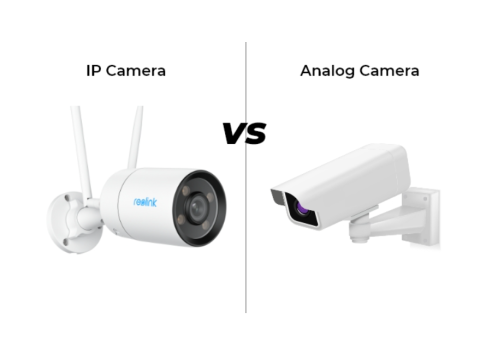Comparing Analog and IP Security Cameras
When it comes to choosing between analog cameras and IP cameras, the decision should focus on the specific needs and objectives of your surveillance system. These two types of cameras differ significantly in technology, functionality, and cost, making them suitable for different scenarios.
1. Key Differences Between Analog and IP Cameras
Resolution and Image Quality
- Analog Cameras: Typically offer resolutions up to 960H (approximately 0.5 MP), sufficient for basic monitoring needs.
- IP Cameras: Provide high-definition (HD) and ultra-HD resolutions, ranging from 1 MP to 4K (8 MP) and beyond.
Flexibility and Scalability
- Analog Systems: Limited to fixed connections via coaxial cables; adding cameras requires more cabling and hardware.
- IP Systems: Highly scalable; connect cameras over existing network infrastructure using Ethernet or WiFi.
Cost
- Analog Cameras: Generally less expensive upfront, including the cameras and DVR systems.
- IP Cameras: Higher initial cost, especially for megapixel cameras and network video recorders (NVRs).
Ease of Installation
- Analog Systems: Simpler setup; often preferred for smaller installations.
- IP Systems: Require more technical expertise for configuration but offer advanced features like Power over Ethernet (PoE).
Advanced Features
- Analog Cameras: Limited in advanced functionalities like analytics and remote management.
- IP Cameras: Support AI-based features, motion detection, facial recognition, and remote access through mobile apps.
2. When to Choose Analog Cameras
Analog cameras remain a reliable choice for:
- Small businesses or residential properties with basic surveillance needs.
- Sites with existing coaxial cable infrastructure.
- Applications where cost-effectiveness and simplicity are priorities.
Use Case Example:
A small retail store requiring basic indoor monitoring without complex video analytics.
3. When to Choose IP Cameras
IP cameras are ideal for:
- Large or complex installations requiring advanced video analytics and high-definition video.
- Systems with existing Ethernet networks, reducing additional cabling needs.
- Scenarios requiring remote access and cloud integration for video storage.
Use Case Example:
A corporate office with multiple floors and a need for remote monitoring and secure data storage.
4. Resolution and Practical Application
While IP cameras often boast high-resolution capabilities, it’s essential to evaluate whether such resolution is necessary. For example:
- Low-Resolution Cameras: Adequate for general monitoring or small indoor spaces.
- High-Resolution Cameras: Crucial for identifying license plates, faces, or other fine details in large or high-risk areas.
5. Pros and Cons of Analog vs. IP Cameras
Analog Cameras
Pros:
- Cost-effective.
- Easier to install and maintain.
- Compatible with older systems.
Cons:
- Limited resolution and features.
- Requires more hardware for expansion.
IP Cameras
Pros:
- Superior image quality.
- Advanced features like motion detection and remote access.
- Highly scalable.
Cons:
- Higher initial costs.
- Requires technical knowledge for setup and maintenance.
6. Conclusion
Choosing between analog and IP cameras depends on your specific requirements, budget, and future scalability plans. Analog cameras are a practical option for small, straightforward systems, while IP cameras excel in flexibility, image quality, and advanced functionality, making them the preferred choice for complex installations.
Invest in the right technology to enhance your surveillance system and ensure peace of mind.

